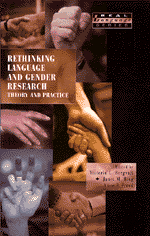

![]()
![]()

Some of the material is not wholly new, possibly because (with one exception) the chapters are developments of papers given at a Conference in 1993: 'Language and Gender Interface: Theories and Methods for Research and Teaching', held in Columbus, Ohio. Also because the contributions stem from this Conference, with the exception of Cameron, the contributors are all based in either the USA or Canada. More seriously, and less understandably, there are relatively few references to work from outside these two countries.
There are eleven chapters, all rightly concerned with theory-building. Seven chapters (by Alice Freed, Alice Greenwood, Livia Polanyi and Diana Strassmann, Susan Ehrlich and Ruth King, Victoria Bergvall, Kira Hall and Virginia O'Donovan, and Mary Bucholz) could further broadly be described as based on empirical data, two (Deborah James and Miriam Meyerhoff) as surveys of literature, and two (Janet Bing and Victoria Bergvall, and Deborah Cameron) as theoretical. Two of the empirical chapters look at gender identities as constructed by academic texts and practices in educational settings, going some way to redress a gap in the literature.
Each chapter has its own bibliography, which is convenient for personal photocopying of individual contributions but which deprives the reader of a very useful 'global' bibliography at the end. However, there is no gratuitous repetition in the different contributions, and the collection is well-edited. The chapters are extensively cross- referenced, after each there is a set of lengthy but fascinating footnotes, and there is an index.
The first chapter, the one written especially for this book, 'The Question of Questions: Beyond Binary Thinking' (Bing and Bergvall) serves as an introduction to the whole volume. Bing and Bergvall appropriately identify what it is about the study of gender that needs to be rethought, but escape the question of 'how' by summarising how each of the contributors addresses this. One wonders if they need have expended so much intellectual energy on the question of the social construction of biological sex when they could have expended more on the conditions under which sex and accordingly gender might cease to become significant social categories, and the lack of reference to the work of Bronwyn Davies (1989, 1993) here is regrettable. Further, Bing and Bergvall show lack of vision as regards a metaphor for gender. They cite West and Fenstermaker's (1995) 'number of intersecting circles to capture the fact that different members of groups share some, but not all, characteristics', the characteristics here being gender, race and class. However a really productive metaphor would surely also take into consideration different sexualities, as well as gender's fluctuating nature, and the fact that femininity and masculinity are, if not always oppositional, almost invariably relational. This suggests something more like an asymmetrical, amoeboid, yin-yang shaped representation, with continual seepage from one side to the other (with 'femininity' doing most of the seeping), in a state of perpetual advance and retreat both inside and outside itself, like a virtual reality 'after dark' computer image.
Much of the work is interdisciplinary, drawing on, in particular, social psychology. Perhaps accordingly, the book offers more to those working on gender than on language, since not all contributors provide the 'close, systematic attention to ... the details of language' requested by Bucholz (p. 267).
By the end of the book it is clear that 'rethinking language and gender research' can mean rather different things. The 'weak' version is to acknowledge (as do James and Meyerhoff) that gender never operates in isolation from other aspects of identity, including ethnicity and age, or from context, in the form of a whole range of linguistic and other social practices to which power is intrinsic. Along related lines is to acknowledge and explore the ways in and conditions under which women and men use language similarly, as Freed convincingly does. A rather different 'rethinking' is to reject the idea of looking at both gender differences (however subtle) and gender similarities in favour of looking at the different constructions of femininities and masculinities by discourse(s) and discursive practices (as do Bergvall, and Hall and O'Donovan), so that gender becomes not a shape at all but rather what Cameron calls a 'set of constitutive acts' (p. 47; my italics). By looking at the discourse which constructs femininities and masculinities, rather than seeing gender as absolute, fixed, and simply characterised by certain language uses, this 'rethinking' takes the debate right away from the familiar undergraduate essay on whether 'dominance' or 'cultural difference' has the greater explanatory power in the study of women's and men's language use, and from crude, global, stereotypical and ultimately reactionary generalisations.
The challenge would now seem to be not to lose sight of disadvantage, and to ensure that in abandoning the dichotomy of male-female language use we do not also refrain from asking 'why some women find some communicative practices more accessible and relevant than others' (Cameron, p. 44), a question, Cameron claims, citing Eckert and McConnell-Ginet (1992), 'of what social practices [women] are permitted/enabled/encouraged to participate in'.
Jane Sunderland
Lancaster University
DAVIES, B. (1993) Shards of Glass. St. Leonards, Australia: Allen and Unwin.
ECKERT, P. and S. McCONNELL-GINET (1992) 'Communities of Practice: Where Language, Gender and Power all Live.' In K. Hall, M. Bucholz and B. Moonwoman (editors) Locating Power: Papers from the Second Berkeley Women and Language Conference. Berkeley Women and Language Group: Berkeley, CA.
HALL, K. and M. BUCHOLZ (editors) (1995) Gender Articulated: Language and the Socially Constructed Self. London: Routledge.
JOHNSON, S. and U. MEINHOF (editors) (1997) Language and Masculinity. Cambridge: Blackwell.
WEST, C. and S. FENSTERMAKER (1995) 'Doing Difference', Gender and Society, vol. 9, no. 1, pp. 8 - 37.